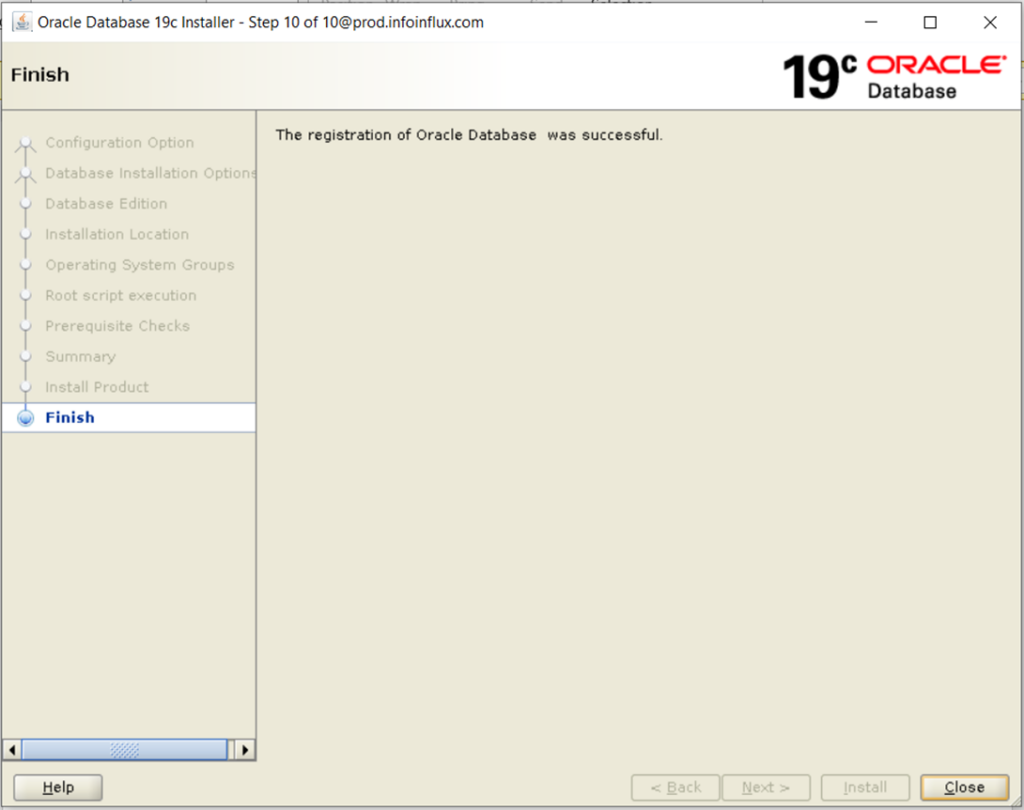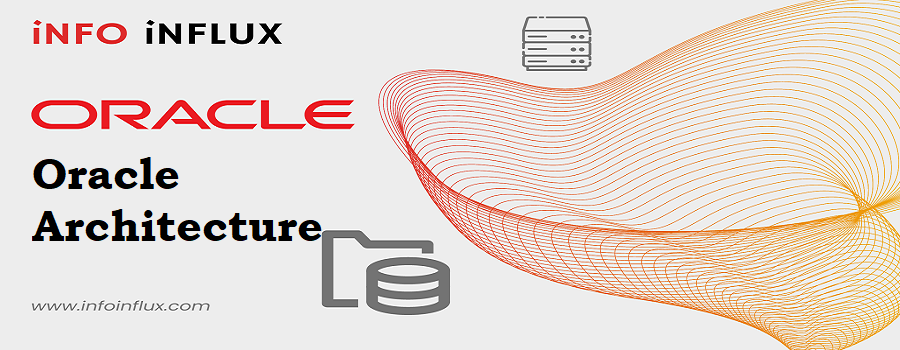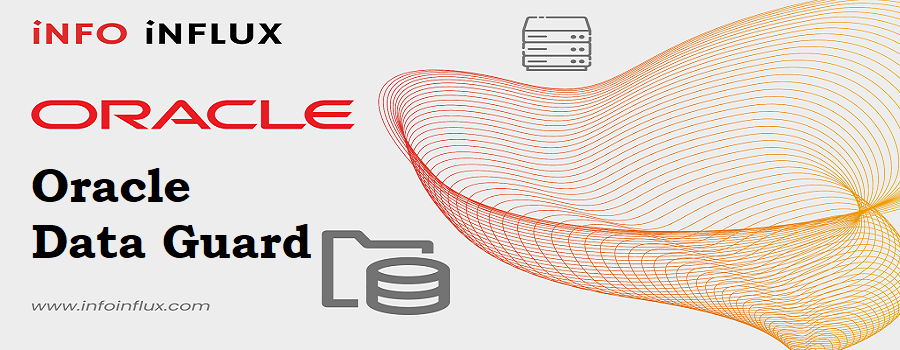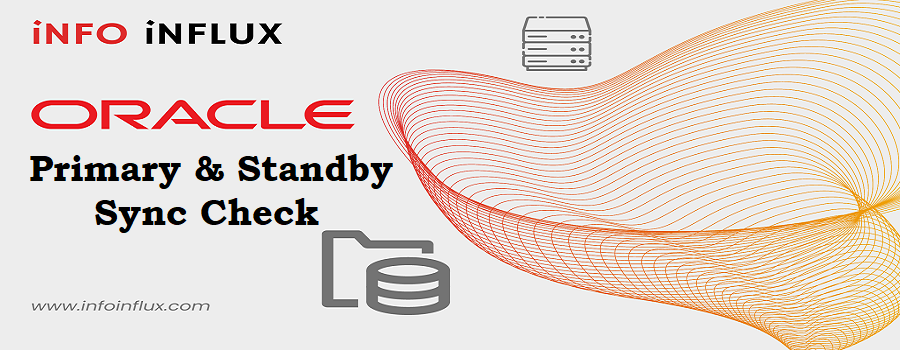Introduction
Upgrade Oracle Database is a crucial step to ensure you’re benefiting from the latest features, performance enhancements, and security updates. In this guide, we’ll walk you through the process of upgrading your Oracle Database 12c to the latest version, 19c.
Follow these steps to ensure a smooth and successful upgrade
Environment
| Hostname | : prod.infoinflux.com |
| Database Name | : PROD |
| DB VERSION | : 12.2.0.1.0 |
| ORACLE_BASE | : /u01/app/oracle |
| DB Home Path | : /u01/app/oracle/product/12.2.0.1/db_1 |
| Datafile Location | : /u01/app/oracle/oradata/PROD |
| Target DB VERSION | : 19.0.0.0 |
| Target DB Path | : /u01/app/oracle/product/19c/db_1 |
| Upgrade Method | : Database Upgrade Assistant |
Steps For upgrade using Database Upgrade Assistant (DBUA):
- Take Latest Database backup
- Make Directory for 19c Home
- Download and Unzip Software to 19c Home Directory
- Install 19c Binary or Software
- Create Pre and Post Upgrade Scripts
- Run Pre-Upgrade Script
- Pre-Upgrade Prerequisites & create guarantee restore Point
- Upgrade Database with Database Upgrade Assistant(DBUA)
- Validate Upgrade & Run Post-upgrade Script
- Drop Restore Point & Change Compatible Parameter
1. Take Latest Database backup
Create Directory for Keeping backup Files: mkdir -p /u01/db_backup/PROD/Other_Files
RMAN BACKUP Location: /u01/db_backup/PROD/
RMAN Backup Taken through Below Script
========================================
run {
allocate channel ch1 device type disk;
allocate channel ch2 device type disk;
backup database format '/u01/db_backup/PROD/PROD_%d_%U_DB.bkp';
sql 'alter system archive log current';
backup archivelog all format '/u01/db_backup/PROD/PROD_%d_%U_ArchiveLog.bkp';
backup current controlfile format '/u01/db_backup/PROD/PROD_%d_ControlFile.bkp';
release channel ch1;
release channel ch2;
}Copy below files to separate backup folder:
** tnsnames.ora
** listener.ora
** sqlnet.ora
** pfile and spfile
** orapw file
Above Files Copy Location: /u01/db_backup/PROD/Other_Files
Create PFile and Current Control File on the same location:
##PFile##
=============
SQL> create pfile='/u01/db_backup/PROD/Other_Files/initPROD.ora' from spfile;
File created.
##Control File##
=================
SQL> alter database backup controlfile to trace as '/u01/db_backup/PROD/Other_Files/controlfile.txt';
Database altered.2. Make Directory for 19c Home
##Make Directories and Give Permissions from Root User##
=================================================
mkdir -p /u01/app/oracle/product/19c/db_1
chown -R oracle:oinstall /u01
chmod -R 775 /u013. Download and Unzip Software to 19c Home Directory
Download or copy the 19c Database software from oracle user to any location as per your requirement. In this case it is /u01
Unzip it to 19c home location: /u01/app/oracle/product/19c/db_1
[oracle@prod u01]$ unzip DB_19C.zip -d /u01/app/oracle/product/19c/db_1Note: If you copied or downloaded it from root user then you have need provide chmod 775 DB_19C.zip file and then unzip it from oracle user
4. Install 19c Binary or Software
Run the Installer:
[oracle@prod db_1]$ cd /u01/app/oracle/product/19c/db_1
Then
[oracle@prod db_1]$ ./runInstaller
Launching Oracle Database Setup Wizard…
Follow the Screens below in Slides:
Run script from Root user : /u01/app/oracle/product/19c/db_1/root.sh
[root@prod ~]# /u01/app/oracle/product/19c/db_1/root.sh
Performing root user operation.
The following environment variables are set as:
ORACLE_OWNER= oracle
ORACLE_HOME= /u01/app/oracle/product/19c/db_1
Enter the full pathname of the local bin directory: [/usr/local/bin]:
The contents of "dbhome" have not changed. No need to overwrite.
The file "oraenv" already exists in /usr/local/bin. Overwrite it? (y/n)
[n]:
The file "coraenv" already exists in /usr/local/bin. Overwrite it? (y/n)
[n]:
Entries will be added to the /etc/oratab file as needed by
Database Configuration Assistant when a database is created
Finished running generic part of root script.
Now product-specific root actions will be performed.
Oracle Trace File Analyzer (TFA - Standalone Mode) is available at :
/u01/app/oracle/product/19c/db_1/bin/tfactl
Note :
1. tfactl will use TFA Service if that service is running and user has been granted access
2. tfactl will configure TFA Standalone Mode only if user has no access to TFA Service or TFA is not installed
Oracle Database 19c Binary installation completed successfully.
5. Create Pre and Post Upgrade Scripts
Generate Scripts:
Make Directory for Scripts
========================
[oracle@prod ~]$ mkdir -p /home/oracle/preupgrade
Set Environment
==================
[oracle@prod ~]$ . oraenv
ORACLE_SID = [PROD] ? PROD
The Oracle base remains unchanged with value /u01/app/oracle
Create Pre and Post Upgrade Scripts
================================
[oracle@prod ~]$ /u01/app/oracle/product/12.2.0.1/db_1/jdk/bin/java -jar /u01/app/oracle/product/19c/db_1/rdbms/admin/preupgrade.jar FILE DIR /home/oracle/preupgrade
==================
PREUPGRADE SUMMARY
==================
/home/oracle/preupgrade/preupgrade.log
/home/oracle/preupgrade/preupgrade_fixups.sql
/home/oracle/preupgrade/postupgrade_fixups.sql
Execute fixup scripts as indicated below:
Before upgrade:
Log into the database and execute the preupgrade fixups
@/home/oracle/preupgrade/preupgrade_fixups.sql
After the upgrade:
Log into the database and execute the postupgrade fixups
@/home/oracle/preupgrade/postupgrade_fixups.sql
Preupgrade complete: 2023-08-22T20:24:48View preupgrade.log:
[oracle@prod ~]$ cat /home/oracle/preupgrade/preupgrade.log
Report generated by Oracle Database Pre-Upgrade Information Tool Version
19.0.0.0.0 Build: 1 on 2023-08-22T20:24:47
Upgrade-To version: 19.0.0.0.0
=======================================
Status of the database prior to upgrade
=======================================
Database Name: PROD
Container Name: PROD
Container ID: 0
Version: 12.2.0.1.0
DB Patch Level: No Patch Bundle applied
Compatible: 12.2.0
Blocksize: 8192
Platform: Linux x86 64-bit
Timezone File: 26
Database log mode: ARCHIVELOG
Readonly: FALSE
Edition: EE
Oracle Component Upgrade Action Current Status
---------------- -------------- --------------
Oracle Server [to be upgraded] VALID
JServer JAVA Virtual Machine [to be upgraded] VALID
Oracle XDK for Java [to be upgraded] VALID
Real Application Clusters [to be upgraded] OPTION OFF
Oracle Workspace Manager [to be upgraded] VALID
OLAP Analytic Workspace [to be upgraded] VALID
Oracle Label Security [to be upgraded] VALID
Oracle Database Vault [to be upgraded] VALID
Oracle Text [to be upgraded] VALID
Oracle XML Database [to be upgraded] VALID
Oracle Java Packages [to be upgraded] VALID
Oracle Multimedia [to be upgraded] VALID
Oracle Spatial [to be upgraded] VALID
Oracle OLAP API [to be upgraded] VALID
==============
BEFORE UPGRADE
==============
REQUIRED ACTIONS
================
None
RECOMMENDED ACTIONS
===================
1. (AUTOFIXUP) Gather stale data dictionary statistics prior to database
upgrade in off-peak time using:
EXECUTE DBMS_STATS.GATHER_DICTIONARY_STATS;
Dictionary statistics do not exist or are stale (not up-to-date).
Dictionary statistics help the Oracle optimizer find efficient SQL
execution plans and are essential for proper upgrade timing. Oracle
recommends gathering dictionary statistics in the last 24 hours before
database upgrade.
For information on managing optimizer statistics, refer to the 12.2.0.1
Oracle Database SQL Tuning Guide.
2. (AUTOFIXUP) Gather statistics on fixed objects prior the upgrade.
None of the fixed object tables have had stats collected.
Gathering statistics on fixed objects, if none have been gathered yet, is
recommended prior to upgrading.
For information on managing optimizer statistics, refer to the 12.2.0.1
Oracle Database SQL Tuning Guide.
INFORMATION ONLY
================
3. To help you keep track of your tablespace allocations, the following
AUTOEXTEND tablespaces are expected to successfully EXTEND during the
upgrade process.
Min Size
Tablespace Size For Upgrade
---------- ---------- -----------
SYSAUX 460 MB 500 MB
SYSTEM 800 MB 912 MB
TEMP 32 MB 150 MB
UNDOTBS1 70 MB 439 MB
Minimum tablespace sizes for upgrade are estimates.
4. Check the Oracle Backup and Recovery User's Guide for information on how
to manage an RMAN recovery catalog schema.
If you are using a version of the recovery catalog schema that is older
than that required by the RMAN client version, then you must upgrade the
catalog schema.
It is good practice to have the catalog schema the same or higher version
than the RMAN client version you are using.
ORACLE GENERATED FIXUP SCRIPT
=============================
All of the issues in database PROD
which are identified above as BEFORE UPGRADE "(AUTOFIXUP)" can be resolved by
executing the following
SQL>@/home/oracle/preupgrade/preupgrade_fixups.sql
=============
AFTER UPGRADE
=============
REQUIRED ACTIONS
================
None
RECOMMENDED ACTIONS
===================
5. Upgrade the database time zone file using the DBMS_DST package.
The database is using time zone file version 26 and the target 19 release
ships with time zone file version 32.
Oracle recommends upgrading to the desired (latest) version of the time
zone file. For more information, refer to "Upgrading the Time Zone File
and Timestamp with Time Zone Data" in the 19 Oracle Database
Globalization Support Guide.
6. To identify directory objects with symbolic links in the path name, run
$ORACLE_HOME/rdbms/admin/utldirsymlink.sql AS SYSDBA after upgrade.
Recreate any directory objects listed, using path names that contain no
symbolic links.
Some directory object path names may currently contain symbolic links.
Starting in Release 18c, symbolic links are not allowed in directory
object path names used with BFILE data types, the UTL_FILE package, or
external tables.
7. (AUTOFIXUP) Gather dictionary statistics after the upgrade using the
command:
EXECUTE DBMS_STATS.GATHER_DICTIONARY_STATS;
Oracle recommends gathering dictionary statistics after upgrade.
Dictionary statistics provide essential information to the Oracle
optimizer to help it find efficient SQL execution plans. After a database
upgrade, statistics need to be re-gathered as there can now be tables
that have significantly changed during the upgrade or new tables that do
not have statistics gathered yet.
8. Gather statistics on fixed objects after the upgrade and when there is a
representative workload on the system using the command:
EXECUTE DBMS_STATS.GATHER_FIXED_OBJECTS_STATS;
This recommendation is given for all preupgrade runs.
Fixed object statistics provide essential information to the Oracle
optimizer to help it find efficient SQL execution plans. Those
statistics are specific to the Oracle Database release that generates
them, and can be stale upon database upgrade.
For information on managing optimizer statistics, refer to the 12.2.0.1
Oracle Database SQL Tuning Guide.
ORACLE GENERATED FIXUP SCRIPT
=============================
All of the issues in database PROD
which are identified above as AFTER UPGRADE "(AUTOFIXUP)" can be resolved by
executing the following
SQL>@/home/oracle/preupgrade/postupgrade_fixups.sql
6. Run Pre-Upgrade Script
Prerequisites before running preupgrade_fixups.sql:
Verify Tablespaces Size For Upgrade through below query
==================================================
SQL>set line 1000
set pages 5000
col tablespace_name for a30
col file_name for a80
col free_space for 9999999
compute sum of total_space on report
compute sum of free_space on report
compute sum of MAX_SPACE on report
break on tablespace_name on report nodup
select c.tablespace_name,a.autoextensible,a.file_name,a.total_space,b.free_space, round(b.free_space/a.total_space *100,2) "Free%",a.max_space from (select file_id,file_name,sum(bytes)/1024/1024 total_space,sum(MAXBYTES)/1024/1024/1024 max_space,autoextensible from dba_data_files group by file_id,file_name,autoextensible) a,(select file_id,nvl(sum(bytes)/1024/1024,0) free_space from dba_free_space group by file_id) b, (select tablespace_name,file_id from dba_data_files) c where a.file_id=b.file_id(+) and a.file_id=c.file_id order by tablespace_name;
Check Invalid Object Count
===========================
SQL> select count(*) from dba_objects where status='INVALID';
COUNT(*)
----------
0
Gather Dictionary Stats
========================
SQL> SET ECHO ON;
SQL> SET SERVEROUTPUT ON;
SQL> EXECUTE DBMS_STATS.GATHER_DICTIONARY_STATS;
PL/SQL procedure successfully completed.
Purge Recyclebin
===================
SQL> PURGE DBA_RECYCLEBIN;
DBA Recyclebin purged.
Refresh Materialized Views
=========================
SQL> declare
list_failures integer(3) :=0;
begin
DBMS_MVIEW.REFRESH_ALL_MVIEWS(list_failures,'C','', TRUE, FALSE);
end;
/
PL/SQL procedure successfully completed.Login in Database and run preupgrade_fixups.sql:
[oracle@prod ~]$ sqlplus / as sysdba
SQL*Plus: Release 12.2.0.1.0 Production on Tue Aug 22 20:27:05 2023
Copyright (c) 1982, 2016, Oracle. All rights reserved.
Connected to:
Oracle Database 12c Enterprise Edition Release 12.2.0.1.0 - 64bit Production
SQL> SET ECHO ON;
SQL> SET SERVEROUTPUT ON;
SQL> @/home/oracle/preupgrade/preupgrade_fixups.sql
SQL> REM
SQL> REM Oracle PRE-Upgrade Fixup Script
SQL> REM
SQL> REM Auto-Generated by: Oracle Preupgrade Script
SQL> REM Version: 19.0.0.0.0 Build: 1
SQL> REM Generated on: 2023-08-22 20:24:44
SQL> REM
SQL> REM Source Database: PROD
SQL> REM Source Database Version: 12.2.0.1.0
SQL> REM For Upgrade to Version: 19.0.0.0.0
SQL> REM
SQL>
SQL> REM
SQL> REM Setup Environment
SQL> REM
SQL> SET ECHO OFF SERVEROUTPUT ON FORMAT WRAPPED TAB OFF LINESIZE 200;
Executing Oracle PRE-Upgrade Fixup Script
Auto-Generated by: Oracle Preupgrade Script
Version: 19.0.0.0.0 Build: 1
Generated on: 2023-08-22 20:24:44
For Source Database: PROD
Source Database Version: 12.2.0.1.0
For Upgrade to Version: 19.0.0.0.0
Preup Preupgrade
Action Issue Is
Number Preupgrade Check Name Remedied Further DBA Action
------ ------------------------ ---------- --------------------------------
1. dictionary_stats YES None.
2. pre_fixed_objects YES None.
3. tablespaces_info NO Informational only.
Further action is optional.
4. rman_recovery_version NO Informational only.
Further action is optional.
The fixup scripts have been run and resolved what they can. However,
there are still issues originally identified by the preupgrade that
have not been remedied and are still present in the database.
Depending on the severity of the specific issue, and the nature of
the issue itself, that could mean that your database is not ready
for upgrade. To resolve the outstanding issues, start by reviewing
the preupgrade_fixups.sql and searching it for the name of
the failed CHECK NAME or Preupgrade Action Number listed above.
There you will find the original corresponding diagnostic message
from the preupgrade which explains in more detail what still needs
to be done.
PL/SQL procedure successfully completed.
7. Pre-Upgrade Prerequisites & create guranteed restore Point
Pre-Upgrade prerequisites
Note:
1. Archive Destination must have enough Space.
Validate Archivelog Mode
===========================
SQL> archive log list
Database log mode Archive Mode
Automatic archival Enabled
Archive destination USE_DB_RECOVERY_FILE_DEST
Oldest online log sequence 41
Next log sequence to archive 43
Current log sequence 43
Check db_recovery_file_dest_size & Increase it if required
===============================================
SQL> show parameter recovery;
NAME TYPE VALUE
------------------------------------ ----------- ------------------------------
db_recovery_file_dest string /u01/app/oracle/fast_recovery_
area/PROD
db_recovery_file_dest_size big integer 8016M
recovery_parallelism integer 0
remote_recovery_file_dest string
Increase the size of db_recovery_file_dest_size
=========================================
SQL> alter system set db_recovery_file_dest_size=15G scope=both;
System altered.
Check db_recovery_file_dest_size
================================
SQL> show parameter recovery;
NAME TYPE VALUE
------------------------------------ ----------- ------------------------------
db_recovery_file_dest string /u01/app/oracle/fast_recovery_
area/PROD
db_recovery_file_dest_size big integer 15G
recovery_parallelism integer 0
remote_recovery_file_dest string
Create Flashback Guaranteed Restore Point
Note:
1. NO need to Enable Flashback Database from 11.2.1.0.1 onwards
2. Archive Log mode should be On
3. Compatible Parameter should be of current version
Flashback On Status
=====================
SQL> select flashback_on from v$database;
FLASHBACK_ON
------------------
NO
Archive Log Mode Check
========================
SQL> select name,open_mode,log_mode from v$database;
NAME OPEN_MODE LOG_MODE
--------- -------------------- ------------
PROD READ WRITE ARCHIVELOG
Compatible Parameter of Current version
====================================
SQL> show parameter compatible
NAME TYPE VALUE
------------------------------------ ----------- ------------------------------
compatible string 12.2.0
noncdb_compatible boolean FALSE
Check for any previous restore Point
=================================
SQL> select * from V$restore_point;
no rows selected
Create FlashBack Guarantee Restore Point
====================================
SQL> create restore point pre_upgrade guarantee flashback database;
Restore point created.
Check Restore Point Details
==========================
SQL> col name for a20
col GUARANTEE_FLASHBACK_DATABASE for a10
col TIME for a60
set lines 190
select NAME,GUARANTEE_FLASHBACK_DATABASE,TIME from V$restore_point;
NAME GUARANTEE TIME
-------------------- ---------- ------------------------------------------------------------
PRE_UPGRADE YES 22-AUG-23 11.55.27.000000000 PM
8. Upgrade Database with Database Upgrade Assistant(DBUA)
Run dbua from 19c Home:
[oracle@prod ~]$ /u01/app/oracle/product/19c/db_1/bin/dbua
Database upgrade has been completed successfully, and the database is ready to use.
9.Validate Upgrade & Run Post-upgrade Script
Validate Upgrade
Verify /etc/oratab
===================
[oracle@prod ~]$ cat /etc/oratab | grep -i PROD
PROD:/u01/app/oracle/product/19c/db_1:N
Verify Time Zone
==================
SQL> SELECT version FROM v$timezone_file;
VERSION
----------
32
Check Invalid Objects
================
SQL> select count(1) from dba_objects where status='INVALID';
COUNT(1)
----------
0
Verify DB Version
====================
SQL> select name,open_mode,version from v$database,v$instance;
NAME OPEN_MODE VERSION
--------- -------------------- -----------------
PROD READ WRITE 19.0.0.0.0
Verify DBA_REGISTRY
====================
SQL> col COMP_ID for a10
col COMP_NAME for a40
col VERSION for a15
set lines 180
set pages 999
select COMP_ID,COMP_NAME,VERSION,STATUS from dba_registry;
COMP_ID COMP_NAME VERSION STATUS
---------- ---------------------------------------- --------------- --------------------------------------------
CATALOG Oracle Database Catalog Views 19.0.0.0.0 VALID
CATPROC Oracle Database Packages and Types 19.0.0.0.0 VALID
JAVAVM JServer JAVA Virtual Machine 19.0.0.0.0 VALID
XML Oracle XDK 19.0.0.0.0 VALID
CATJAVA Oracle Database Java Packages 19.0.0.0.0 VALID
APS OLAP Analytic Workspace 19.0.0.0.0 VALID
RAC Oracle Real Application Clusters 19.0.0.0.0 OPTION OFF
XDB Oracle XML Database 19.0.0.0.0 VALID
OWM Oracle Workspace Manager 19.0.0.0.0 VALID
CONTEXT Oracle Text 19.0.0.0.0 VALID
ORDIM Oracle Multimedia 19.0.0.0.0 VALID
SDO Spatial 19.0.0.0.0 VALID
XOQ Oracle OLAP API 19.0.0.0.0 VALID
OLS Oracle Label Security 19.0.0.0.0 VALID
DV Oracle Database Vault 19.0.0.0.0 VALID
15 rows selected.
Run Post-Upgrade Script
Login in SQL & run: @/home/oracle/preupgrade/postupgrade_fixups.sql
SQL> @/home/oracle/preupgrade/postupgrade_fixups.sql
Session altered.
PL/SQL procedure successfully completed.
PL/SQL procedure successfully completed.
PL/SQL procedure successfully completed.
Package created.
No errors.
Package body created.
PL/SQL procedure successfully completed.
No errors.
Package created.
No errors.
Package body created.
No errors.
Executing Oracle POST-Upgrade Fixup Script
Auto-Generated by: Oracle Preupgrade Script
Version: 19.0.0.0.0 Build: 1
Generated on: 2023-08-22 23:58:37
For Source Database: PROD
Source Database Version: 12.2.0.1.0
For Upgrade to Version: 19.0.0.0.0
Preup Preupgrade
Action Issue Is
Number Preupgrade Check Name Remedied Further DBA Action
------ ------------------------ ---------- --------------------------------
3. old_time_zones_exist YES None.
4. dir_symlinks YES None.
5. post_dictionary YES None.
6. post_fixed_objects NO Informational only.
Further action is optional.
The fixup scripts have been run and resolved what they can. However,
there are still issues originally identified by the preupgrade that
have not been remedied and are still present in the database.
Depending on the severity of the specific issue, and the nature of
the issue itself, that could mean that your database upgrade is not
fully complete. To resolve the outstanding issues, start by reviewing
the postupgrade_fixups.sql and searching it for the name of
the failed CHECK NAME or Preupgrade Action Number listed above.
There you will find the original corresponding diagnostic message
from the preupgrade which explains in more detail what still needs
to be done.
PL/SQL procedure successfully completed.
Session altered.10. Drop Restore Point & Change Compatible Parameter
Drop Restore Point
You Must drop restore point before changing the Compatible Parameter. As you cannot revert back once parameter is changed.
Check restore point name & details
===============================
SQL> col name for a20
col GUARANTEE_FLASHBACK_DATABASE for a10
col TIME for a60
set lines 190
select NAME,GUARANTEE_FLASHBACK_DATABASE,TIME from V$restore_point;
NAME GUARANTEE_ TIME
-------------------- ---------- ------------------------------------------------------------
PRE_UPGRADE YES 22-AUG-23 11.55.27.000000000 PM
Drop Restore Point
==================
SQL> drop restore point PRE_UPGRADE;
Restore point dropped.
Validate
=============
SQL> select NAME,GUARANTEE_FLASHBACK_DATABASE,TIME from V$restore_point;
no rows selectedChange Compatible Parameter
Important: If the value of the COMPATIBLE parameter is changed to 19.0.0 then if for some reasons database needs to be downgraded to 12.2.0 we would not have any option other than export/import to downgrade the database. We can easily downgrade the database if for some reason it has to be downgraded to lower version before changing the COMPATIBLE parameter. That’s why it is recommended to change COMPATIBLE parameter once you are fully sure Upgraded database is performing well.
Check Current Compatible value
=================================
SQL> show parameter COMPATIBLE
NAME TYPE VALUE
------------------------------------ ----------- ------------------------------
compatible string 12.2.0
noncdb_compatible boolean FALSE
Change Compatible value to upgrade version
========================================
SQL> ALTER SYSTEM SET COMPATIBLE = '19.0.0' SCOPE=SPFILE;
System altered.
Restart Database
==============
SQL> shut immediate;
Database closed.
Database dismounted.
ORACLE instance shut down.
SQL> startup
ORACLE instance started.
Total System Global Area 2516581464 bytes
Fixed Size 8899672 bytes
Variable Size 536870912 bytes
Database Buffers 1962934272 bytes
Redo Buffers 7876608 bytes
Database mounted.
Database opened.
Validate Compatible Parameter value
==================================
SQL> show parameter COMPATIBLE
NAME TYPE VALUE
------------------------------------ ----------- ------------------------------
compatible string 19.0.0
noncdb_compatible boolean FALSE
Validate Database version
=========================
SQL> select name,open_mode,version from v$database,v$instance;
NAME OPEN_MODE VERSION
-------------------- -------------------- ---------------
PROD READ WRITE 19.0.0.0.0Take Fresh Backup of Upgraded Database
Conclusion
Upgrading Oracle Database 12c to 19c is a vital task to stay up-to-date with the latest features and security enhancements. By following these steps and carefully preparing and executing the upgrade, you can ensure a smooth transition and reap the benefits of improved performance and functionality in Oracle Database 19c. Always refer to the official Oracle documentation and seek professional assistance if needed to ensure a successful upgrade process.


























